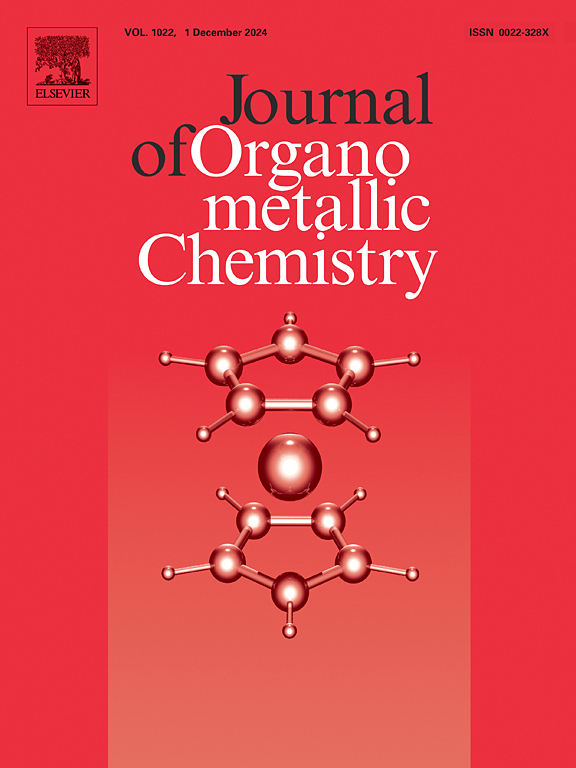α-Fe2O3/CeBi2O2CO3 decorated with Pd as an efficient photo-assisted catalyst for Suzuki-Miyaura coupling (SMC) under visible light irradiation
IF 2.1
3区 化学
Q3 CHEMISTRY, INORGANIC & NUCLEAR
引用次数: 0
Abstract
In this research work, α-Fe2O3/CeBi2O2CO3-Pd was prepared using hydrothermal method and characterized using different physical techniques. It was used as photocatalyst for the C![]() C Suzuki-Miyaura coupling reactions between halobenzene and phenylboronic acid with electron-withdrawing and electro-donating groups on the reactants. The photocatalytic C
C Suzuki-Miyaura coupling reactions between halobenzene and phenylboronic acid with electron-withdrawing and electro-donating groups on the reactants. The photocatalytic C![]() C Suzuki-Miyaura coupling reaction was carried out in the mixed solvent (H2O/EtOH, 1:1) at room temperature under visible light irradiation. The results showed that, the presence of the electron-withdrawing groups (-CF3) on iodobenzene as well as those of electron-donating groups (-CH3) on the arylboronic acids leads to excellent conversion (100 %) in 10 min, whereas the opposite; i.e., electron-donating groups (-CH3) on iodobenzene and electron-withdrawing groups (-CF3) on the arylboronic acids lowers the conversion drastically to only 77 % in 4 h. The prepared catalyst has a good stability that does not make a significant change in the efficiency of the catalyst after 6th runs.
C Suzuki-Miyaura coupling reaction was carried out in the mixed solvent (H2O/EtOH, 1:1) at room temperature under visible light irradiation. The results showed that, the presence of the electron-withdrawing groups (-CF3) on iodobenzene as well as those of electron-donating groups (-CH3) on the arylboronic acids leads to excellent conversion (100 %) in 10 min, whereas the opposite; i.e., electron-donating groups (-CH3) on iodobenzene and electron-withdrawing groups (-CF3) on the arylboronic acids lowers the conversion drastically to only 77 % in 4 h. The prepared catalyst has a good stability that does not make a significant change in the efficiency of the catalyst after 6th runs.

Pd修饰α-Fe2O3/CeBi2O2CO3在可见光下作为Suzuki-Miyaura偶联(SMC)的光辅助催化剂
本文采用水热法制备了α-Fe2O3/CeBi2O2CO3-Pd,并采用不同的物理技术对其进行了表征。用它作为光催化剂,催化了卤苯与苯硼酸的CC Suzuki-Miyaura偶联反应,反应物上有吸电子基团和供电基团。在可见光照射下,在混合溶剂(H2O/EtOH, 1:1)室温下进行了CC Suzuki-Miyaura光催化偶联反应。结果表明:碘苯上的吸电子基团(-CF3)和芳基硼酸上的供电子基团(-CH3)在10 min内的转化率达到100%,而芳基硼酸上的供电子基团(-CH3)的转化率则相反;即碘苯上的给电子基团(-CH3)和芳基硼酸上的吸电子基团(-CF3)使转化率在4 h内急剧降低,仅为77%。制备的催化剂稳定性好,6次运行后效率没有明显变化。
本文章由计算机程序翻译,如有差异,请以英文原文为准。
求助全文
约1分钟内获得全文
求助全文
来源期刊

Journal of Organometallic Chemistry
化学-无机化学与核化学
CiteScore
4.40
自引率
8.70%
发文量
221
审稿时长
36 days
期刊介绍:
The Journal of Organometallic Chemistry targets original papers dealing with theoretical aspects, structural chemistry, synthesis, physical and chemical properties (including reaction mechanisms), and practical applications of organometallic compounds.
Organometallic compounds are defined as compounds that contain metal - carbon bonds. The term metal includes all alkali and alkaline earth metals, all transition metals and the lanthanides and actinides in the Periodic Table. Metalloids including the elements in Group 13 and the heavier members of the Groups 14 - 16 are also included. The term chemistry includes syntheses, characterizations and reaction chemistry of all such compounds. Research reports based on use of organometallic complexes in bioorganometallic chemistry, medicine, material sciences, homogeneous catalysis and energy conversion are also welcome.
The scope of the journal has been enlarged to encompass important research on organometallic complexes in bioorganometallic chemistry and material sciences, and of heavier main group elements in organometallic chemistry. The journal also publishes review articles, short communications and notes.
 求助内容:
求助内容: 应助结果提醒方式:
应助结果提醒方式:


